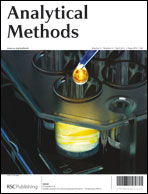A new simple, sensitive and cost effective supramolecular-based dispersive liquid–liquid microextraction (SM–DLLME) has been reported in very high concentration of salt. The contaminant used as a model was Orange II, an anionic dye, and was preconcentrated without any derivatization or ion-pair formation reaction. This new method can determine the analytes in high concentration of salt (up to 5 M) and does not need any kind of disperser agent. In the novel technique developed here, decanoic acid (extraction solvent) is dissolved in a mixture of tetrabutylammonium hydroxide (Bu4NOH) (self-assembly agent) and tetrabutylammonium bromide (Bu4NBr) (salting-in agent) which make up the vesicles and extract the analytes from samples. Several important factors influencing the extraction efficiency of Orange II and its subsequent determination were investigated and optimized. Under the optimized conditions and preconcentration of only 5.00 ml of sample, the enhancement factor was 74, limit of detection (LOD) was 0.35 μg L−1 and relative standard deviations (RSDs) for 45 μg L−1 and 100 μg L−1 of Orange II in different samples were 3.7% and 2.9%, respectively (n = 6).

You have access to this article
 Please wait while we load your content...
Something went wrong. Try again?
Please wait while we load your content...
Something went wrong. Try again?


 Please wait while we load your content...
Please wait while we load your content...